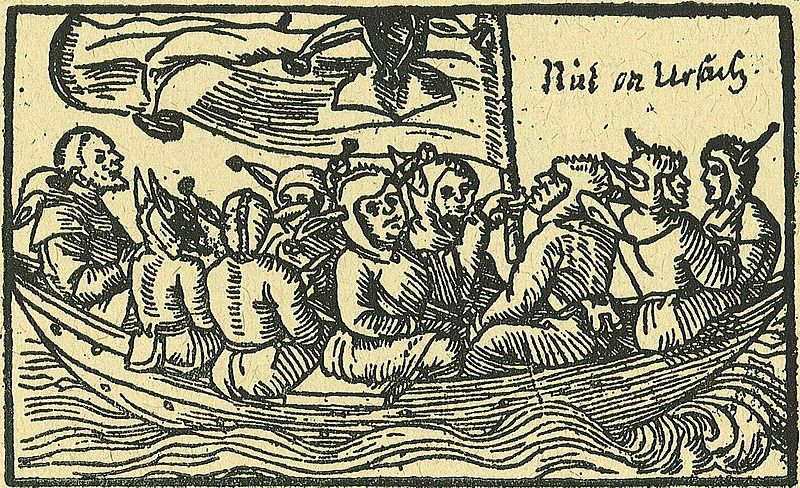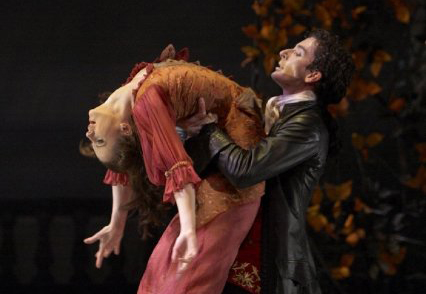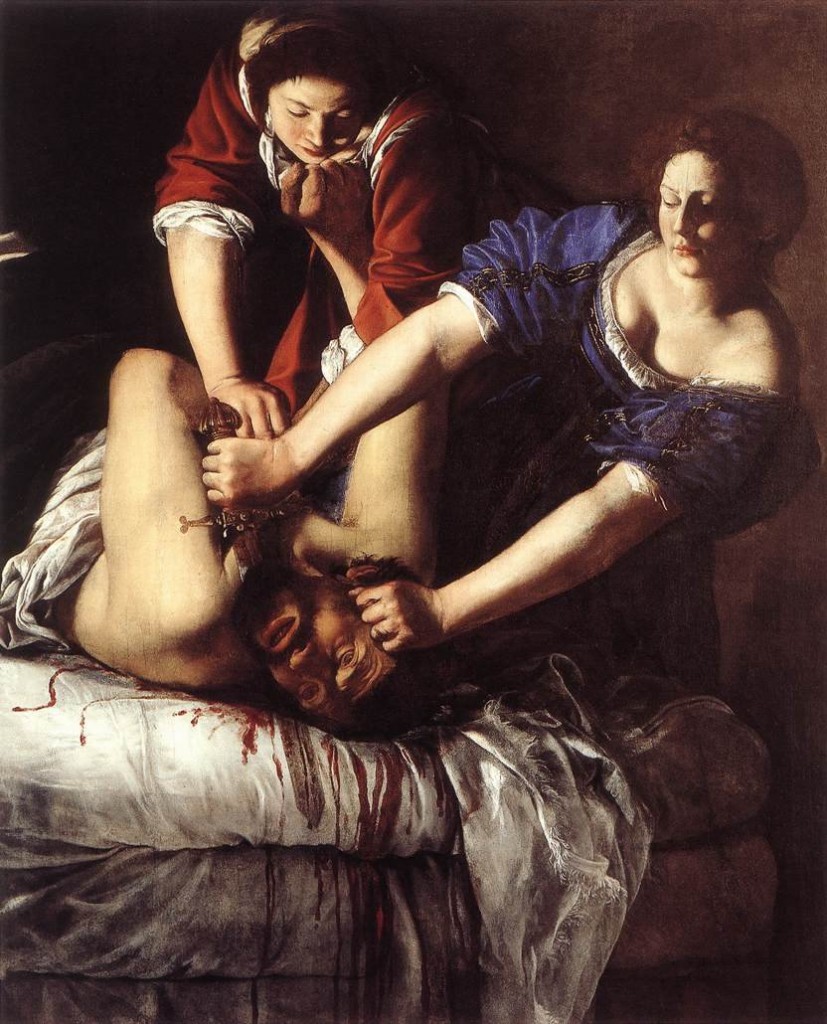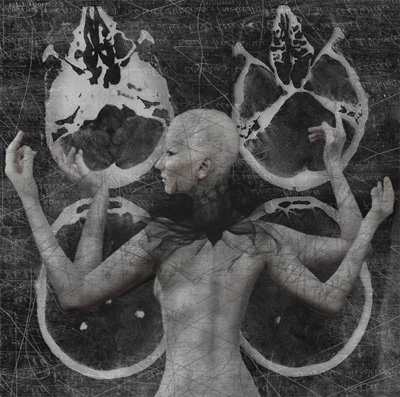Only then can we see how madness and non‐madness are NOT two distinct phenomena, but rather are in dialogue, “are inextricably involved” … “In the severe world of mental illness, modern man no longer communicates with the madman” . The physician speaks to the madman only by way of seeing the person as having a disease; the dialogue with madness is broken. “The language of psychiatry, which is a monologue of reason about madness, has been established only on the basis of such a silence” … does not write a history of that language of medicine; he tries to write “and archeology of that silence” . The reason/madness nexus constitutes for Western culture “one of its dimensions of originality” …. So, how does one go about listening to a language of madness that does not follow the predicates of reason? This realm points to the “limits” of a culture, not it’s identity, or what’s already possible. ( Michel Foucault )

Heinrich von Kleist.Penthesilea. "she pounces, tearing the armor from his body; and now she sinks her teeth into his white breast, she and the dogs, her rivals; Oxus and Dirke drive their fangs into his right, she into his left side; when I cam upon them, the blood was dripping from her mouth and hands."
The Romantic Age had a penchant for madness; hence all the mad scenes that marked the artists’ revolt against reason. The arts of the preceding epoch had celebrated the Great and the Beautiful; but now it is not field marshals on horseback or gentlewoman being serenaded in pleasure gardens, but rather demons of lust who ride wildcats and broomsticks. The only beautiful woman are the ones being sold by hideous whoremongers, and the myth of the polite, perfectible society is transformed into repulsive images. ….

"Michel Foucault, who wrote Madness and Civilization, saw in the ship of fools a symbol of the consciousness of sin and evil alive in the medieval mindset and imaginative landscapes of the Renaissance… Renaissance men developed a delightful, yet horrible way of dealing with their mad denizens: they were put on a ship and entrusted to mariners because folly, water, and sea, as everyone then “knew,” had an affinity for each other. Thus, “Ship of Fools” crisscrossed the sea and canals of Europe with their comic and pathetic cargo of souls. Some of them found pleasure and even a cure in the changing surroundings, in the isolation of being cast off, while others withdrew further, became worse, or died alone and away from their families. The cities and villages which had thus rid themselves of their crazed and crazy, could now take pleasure in watching the exciting sideshow when a ship full of foreign lunatics would dock at their harbors."
The Romantic Age (1750-1870 ) saw almost a love-hate relationship with the insane; an attraction-repulsion complex towards the aesthetic of lunacy; a wish to segregate the insane from the rest of the population, and also a wariness of the terrifying prospect of the wrongful confinement of sane people.
In Britain, The trial of Daniel McNaughton in 1843 for the assassination of Sir Robert Peel’s Private Secretary, and the subsequent legislation, provoked general public debate about the nature of madness. Many Victorian writers had personal experience of
the effects of mental illness. Thackeray’s wife became insane after the birth of their third child. Bulwer- Lytton had his wife committed to a private asylum, although she later refuted the charge of insanity in her memoirs. Dickens visited asylums in England
and America, and was also friendly with Dr John Conolly. Charlotte Bronte studied phrenology and, like her sisters, witnessed the psychological deterioration of her brother, Branwell. Charles Reade successfully campaigned for the release of a wealthy man he believed wrongfully confined in an asylum.

Goya. The Madhouse. "Though madness is not the only language "common to the work of art and the modern world...but (rather) through madness, a work that seems to drown in the world, to reveal there its non-sense, and to transfigure itself with the features of pathology alone, (it) actually engages within itself the world's time, masters it, and leads it; by the madness which interrupts it, a work of art opens a void, a moment of silence, a question without an answer, provokes a breach without reconciliation where the world is forced to question itself."- Foucault
In Charlotte Bronte’s novel Jane Eyre (1847)we meet one of the most famous mad characters in 19th century fiction: Mrs Rochester. Her introduction is not encouraging:
“In the deep shade, at the further end of the room, a figure ran backwards and forwards. What it was, whether beast or human being, one could not, at first sight, tell: it grovelled, seemingly on all fours; it snatched and growled like some strange, wild animal: but it was covered with clothing: and a quantity of dark, grizzled hair, wild as a mane, hid its head and face.”

Michel Foucault:"And on Nietzsche & Artaudian madness..."(it) is the absolute break with the work of art; it forms the constitutive moment of abolition, which dissolves in time the truth of the work of art; it draws the exterior edge, the line of dissolution, the contour against the void (into which they slipped)...Madness is no longer the space of indecision through which it was possible to glimpse the original truth of the work of art, but the decision beyond which this truth ceases irrevocably, and hangs forever over history."
There is no sympathy in this account, only fear and revulsion. Clearly, madness is seen as a state of degradation and bestiality. This is reinforced by referring to Mrs Rochester as “it” and later as a “clothed hyena” standing on “its hind feet”. At one stage she is compared to a “Vampyre” and this occult allusion further emphasises the essential “otherness” of madness. In the novel we learn a little about
her background but this only serves to increase her negative qualities. Thus she has a strong fam
Emily Bronte’s strange and compelling novel Wuthering Heights ( 1847) occupies a unique place in English literature and, unlike the other novels of its era, it is less concerned with the affairs of contemporary society than with the emotional and psychological lives of its individual characters. It is a complex novel and the depiction of madness reflects the interweaving themes of the work. Thus madness is seen to partake of the supernatural; the diabolical; the mystic; the expression of passion; and, more prosaically, the physical symptoms of illness.

"Visiting Assistant Professor of Performing Arts Natsu Onoda Power’s latest production, Madness and Civilization, is inspired by French philosopher Michel Foucault’s 1961 book of the same name. On a trip to New Jersey to visit her brother-in-law, who is mentally ill, Onoda Power and her husband discussed Foucault's book in the context of modern treatments. She realized that a play titled Madness and Civilization would be something she would be interested in developing and directing. The book Madness and Civilization is an excerpt of Foucault’s seminal work The History of Madness, which was only fully translated into English and published in 2006. While the book discusses case studies for specific patients and descriptions of treatment procedures, Foucault also discussed the tradition of excluding or containing those considered insane or mad. The book also examines literature and art relating to madness, and Onoda Power found the intersection of treatment, culture and creative process inspiring. "
In the novel, Catherine has two episodes of mental instability which are described in some detail. Interestingly, Emily Bronte was one of the first writers in English literature to use the term “mental illness”. Catherine’s actual decline into madness is well summarised by the housekeeper, Nellie Dean:
“It commenced in a quarrel.Shewas struck during a tempest of passion with a kind of fit…. she refused to eat, and now she alternatively raves and remains in a half-dream, knowing those about her, but having her mind filled, with all sorts of strange ideas and illusions”. Nellie Dean’s account emphasises one of the key elements in Catherine’s madness – the expression of her passionate nature which is contrasted with her husband’s “cold blood”.

1944: Orson Welles (1915 - 1985) and Joan Fontaine star as Mr Rochester and Jane in a scene from 'Jane Eyre', adapted from the novel by Charlotte Bronte. The film was directed by Robert Stevenson for 20th Century Fox. (Photo by Hulton Archive/Getty Images)
In a passage which evokes the mystical aspect of her condition, Catherine is described as “altered … but when she was calm, there seemed unearthly beauty in the change … (her eyes) appeared always to gaze beyond, and far beyond-you would have said out of this world”. The association between Catherine’s madness and diabolism is made when Heathcliff asks her on her sick bed if she is possessed by the devil. The physical aspects of her breakdown are noted in her inability to eat or sleep. Thus many disparate elements unite in this intricate picture of a mind of turmoil.

Chaplin. Monsieur Verdoux. " Certainly this attitude toward madness and sanity, adaptation and maladaptation, finds its popular apotheosis in the 1950s in the pop writing of the Beats, but it goes back much further than that; one can see it at work in many of the comedies that came out of early Hollywood, particularly in the work of the most popular entertainer who ever lived, the first universally recognizable symbol in the global village: Charles Spencer Chaplin. Issues of sanity and madness were on Chaplin's mind when he made Verdoux. In an interview, he called Verdoux a "madman," and said, "When a thing is overstated it becomes ridiculous. This is the salvation of man's sanity." At the press conference for Verdoux, Chaplin stated, "We are going to grow up a bunch of neurotics."
As the madman had replaced the leper, the mentally ill person was now a subhuman and beastly scape-goat; hence the need to protect others. While the Quaker Tuke applied his religious principles, first to demented “friends” and later to foes also, partly to convert them, the great Pinel was not sure at times that he was dealing with sick people; he often marveled at their unbelievable endur-ance of physical hardship, and often cited the ability of schizophrenic women to sleep naked in subfreezing tem-peratures without suffering any ill effects. Were not these people more healthy, more resistant than ordinary human beings? Didn’t they have too much animal spirit in them? ( Foucault )
In his psychoanalytic study of “Madness and Civilization” the French historian Michel Foucault describes Sade’s case as a key to the new mental images that emerged at the end of the eighteenth century, among them “the complicity of desire and murder, of cruelty and the longing to suffer, of sovereignty and slavery, of insult and humiliation.” In Foucault’s view , the dialectics of sadism corresponded to the passions of the age.

Wuthering Heights ballet. "The dancers, coupled with Nixon's fabulous choregraphy and Schonberg's music, were fantastic. In perfect synchronisation, they are throughly engaging throughout in the turbulent emotions involved in the journey of this doomed love affair which concludes on a beautiful note, with the young Heathcliff and Cathy united on the moor, capturing snow flakes."
“It would soon reach, under the Empire, a point that had never been attained in the Middle Ages and the Renaissance; the strange Brotherhood of the Blue Ship had once given performances in which madness was mimed; now it was madness itself, madness in flesh and blood, which put on the show. Early in the nineteenth century, Coulmier, the director of Charenton, had organized those famous performances in which madmen sometimes played the roles of actors, sometimes those of watched spectators. “The insane who attended these theatricals were the object of the attention and curiosity of a frivolous, irresponsible, and often vicious public. The bizarre attitudes of these un-fortunates and their condition provoked the mocking laughter and the insulting pity of the spectators.”Madness became pure spectacle, in a world over which Sade extended his sovereignty and which was offered as a diversion to the good conscience of a reason sure of itself. Until the beginning of the nineteenth century, and to the indignation of Royer-Collard, madmen remained monsters-that is, etymologically, beings or things to be shown. Confinement hid away unreason, and betrayed the shame it aroused; but it explicitly drew attention to madness, pointed to it.

"And then came Artemisia Gentileschi. Artemisia, without the strings of any Church commission attached. Artemisia, who had herself been raped. Artemisia Gentileschi did not make ‘nicey-nicey’. Artemisia Gentileschi in 1620 was the first to paint a ‘feminist’ Judith. Her father Orazio had also painted Judith—a conventional Judith. Michelangelo, Botticelli and Caravaggio had painted Judith. Donatello had sculpted Judith. Gentileschi’s painting is dark, darker and more dramatic than Caravaggio’s and others’ Judiths. A theatrical spotlight is trained on the action, on the struggling limbs. The shadows on Judith’s arms force us to acknowledge the sawing, crunching, ‘why-is-this-neck-gristle-and-bone-so-tough?’ sword action she uses to get his head off. The extent of the blood splayed around the scene gives us a pretty clear idea that Gentileschci believes this was not a quick death, nor should it have been. Nor was this murder a workmanly job ineptly done. No, there is a realist’s quality of gratuitous suffering; of ‘extraordinary rendition’ as they say; of cold-blooded torture. The feminist righteous violence of Artemisia Gentileschi’s painting(s) is very close to the moral quality that Livljanić projects in the Dialogos production of Judith. Livljanić’s text has Holofernes’s dying going on and on... "
Obviously, it isn’t necessary “to be in a habitual state of licentious insanity” , as Sade’s police record described him, before one can write about it; the authors of some of the maddest mad scenes were unequivocally sane. But there were more than a few who wrote about insanity because they had a strong streak of it in themselves.
Heinrich von Kleist, the great poet of the German romantic theatre, belongs to this category: he pictured the world as a stage battleground on which to act out his sexual fantasies. The climactic scene of Kleist’s masterpiece, “Penthesilea”, is a kind of inverted prophecy of the sadistic finale with which he was to end his own life: in 1811, shortly after his thirty-fourth birthday, he shot his mistress and himself.
Penthesilea, queen of the Amazons, is a neo-Grecian version of that familiar romantic figure, “la belle dame sans merci” – a man-eating woman who destroys her lover in a sudden fit of feminist resentment. She has met Achilles on the battlefield and yielded him her heart, and for a time love triumphs over war. Then while the nuptial feast is being made ready, her Amazon blood lust surges up again. Tracking Achilles with her hounds, she shoots him through the throat just as he is about to throw himself at her feet.

"Artaud believed that civilization had turned man into a sick and repressed creature and that the true function of the theatre was to rid man of these repressions and liberate his instinctual energy. He proposed removing the barrier of the stage between performers and audience and producing mythic spectacles that would include verbal incantations, groans and screams, pulsating lighting effects, and oversized stage puppets and props. Although only one of Artaud's plays, Les Cenci (1935), based on works by Percy Bysshe Shelley and Stendhal, was ever produced to illustrate these theories, his ideas influenced the productions of Jean-Louis Barrault, Jerzy Grotowski, Jean Vilar, and The Living Theatre as well as the work of such playwrights as Arthur Adamov, Jean Genet, and Jacques Audiberti."
“And all the while the Queen was drawing near, Her pack of dogs apace behind her, scanning The woods and towering mountains, like a hunter; And just as he begins to part the boughs In order to sink down before her feet: Aha! The antlers give away the stag, She cries, and, with the strength of madness, draws The bow until the two ends kiss, And raises up the bow and aims and shoots, And drives an arrow through his throat; he falls. …He, crimson with his own blood, writhing, reaches Out to her soft cheek, touches her, and cries: Penthesilea! My bride! What are you doing? Is this the rosy feast you promised me?”
This is a scene that left most of Kleist’s contemporaries speechless with horror. His penchant for cruel and unusual punishments anticipates the Theatre of Cruelty, with which another mad genius of the stage, Antonin Artaud, attempted to reform the theatre of the twentieth century. Certainly he would have agreed with Artaud that cruelty is what cements the world together, that cruelty “molds the features of the created world.” Kleist represents an extreme case of the artist who identifies himself with madness and who compels his nightmares to represent him on the public stage.

"The term "god helmet" is used to describe a headpiece that induces so-called mystical experiences by electromagnetic stimulation of certain areas of the brain. Since this research is an on-going process, the actual efficiency of this device is open for debate."
“Kleist had hoped to win Goethe’s respect, and with it the respect of his age, with Penthesilea. But Goethe, whose watchwords were balance, restraint, and renunciation, could not admire a play that drove violence, lust, and nihilistic rage to their outermost tragic consequences. In a January 1808 letter to Kleist (the only one Goethe ever wrote him), he bluntly rejected the work. Kleist, a lonely and vulnerable soul under the best of circumstances, was devastated. The snub probably clinched his sense of exile.” ( Maurice Sendak )
pascal: “Men are so necessarily mad, that not to be mad would amount to another form of madness.” And Dostoievsky, in his diary of a writer: “It is not by confining one’s neighbor that one is convinced of one’s own sanity.” We have yet to write the history of that other form of madness, by which men, in an act of sovereign reason, con-fine their neighbors, and communicate and recognize each
other through the merciless language of non-madness; to define the moment of this conspiracy before it was perma-nently established in the realm of truth, before it was re-vived by the lyricism of protest. We must try to return, in history, to that zero point in the course of madness at which madness is an undifferentiated experience, a not yet divided experience of division itself. We must describe, from the start of its trajectory, that “other form” which relegates Reason and Madness to one side or the other of its
action as things henceforth external, deaf to all exchange, and as though dead to one another.
This is doubtless an uncomfortable region. To explore it we must renounce the convenience of terminal truths, and never let ourselves be guided by what we may know of madness. None of the concepts of psychopathology, even and especially in the implicit
process of retrospections, can play an organizing role. What is constitutive is the action that divides madness, and not the science elaborated once this division is made and calm restored. What is originative is the caesura that establishes the distance between reason and non-reason; reason’s subjugation of non-reason, wresting from it its truth as madness, crime, or disease, derives explicitly from this point…” ( Foucault )





 COMMENTS
COMMENTS